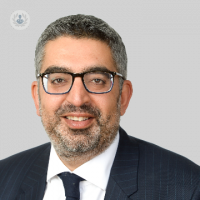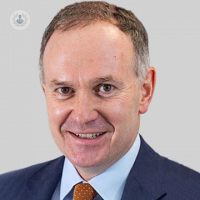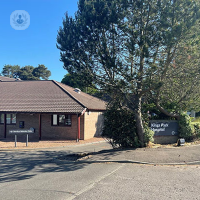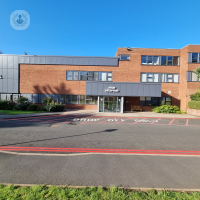What is Dupuytren's contracture?
Dupuytren's contracture, or Dupuytren's disease, is a hand deformity that consists of the thickening of tissues located under the palm of the hand and results in one or more of the fingers becoming permanently bent in a flexed position.
When the syndrome starts, knots or lumps form in the palm that prevent the fingers from straightening. Daily activities, such as handshaking or putting your hand in your pocket, can be complicated.
This condition typically affects the ring finger and the little finger and can get slowly worse over many months or years. It is more prevalent in older men originating in Northern Europe.
Dupuytren's contracture can be treated by an orthopaedic surgeon, specialising in hand and wrist conditions.

Symptoms of Dupuytren's contracture
The first symptom of Dupuytren's contracture is the appearance of a hard (callus-like) nodule in the palm that can bother you but typically doesn’t cause any pain.
In the later stages of Dupuytren's contracture, tissue cords form under the skin on the palm that can extend to the fingers. As these cords contract, the fingers bend closer to the palm.
The ring finger and little finger are usually the most affected, but the middle finger may also be involved. Rarely, the index finger and thumb are affected. Both hands are susceptible to Dupuytren's contracture but generally, one of them is more severe than the other.
This disease generally progresses slowly over many years.
How is Dupuytren's contracture treated?
Surgical treatment can usually restore normal finger movement. The disease does recur after surgery in up to half of cases after ten years.
If the condition is left untreated, it will progress until the hand cannot be fully opened.
Medical tests for Dupuytren's contracture
Most of the time, a specialist will perform a physical examination to make a diagnosis. To complete the diagnosis, the specialist might ask you to perform a series of exercises such as placing the hand open on a table or flat surface to see if you can fully stretch your fingers.
What causes Dupuytren's contracture?
The cause of Dupuytren's contracture is unknown, but it could be associated with certain biochemical factors within the affected tissue. Knowing the risk factors can allow for early detection and treatment.
Factors that increase the risk of developing this condition include:
- Age - occurs more frequently after the age of 40.
- Sex - men are more likely to develop Dupuytren’s contracture than women.
- Genetics - people of Northern European descent are at increased risk of developing the condition.
- Family history - Dupuytren's contracture is often hereditary.
- Tobacco and alcohol use - Smoking is associated with an increased risk of Dupuytren's contracture, perhaps due to microscopic changes in smoking caused by blood vessels. Alcohol consumption is also associated with Dupuytren's contracture.
- Diabetes - people with diabetes have been reported to be at increased risk of developing Dupuytren's contracture.
Treatments for Dupuytren's contracture
Physiotherapy can be used to restore the function of the hand and gain strength and mobility.
Dupuytren’s treatment may consist of the following:
- Surgery is an option for people with an advanced condition, who have limited function, or where the disease is progressing. The goal is to surgically remove the affected palm tissue.
- Radiotherapy can be used to irradiate any nodules and cords associated with Dupuytren’s.
- An experimental technique based on using collagenase injections.
Which specialist treats you?
The specialist that treats this condition is typically an orthopaedic surgeon. An orthopaedic surgeon treats fractures or injuries to bones, muscles, joints and ligaments.
02-10-2017 10-24-2023Dupuytren’s contracture
Mr Kunal Hinduja - Orthopaedic surgery
Created on: 02-10-2017
Updated on: 10-24-2023
Edited by: Jay Staniland
What is Dupuytren's contracture?
Dupuytren's contracture, or Dupuytren's disease, is a hand deformity that consists of the thickening of tissues located under the palm of the hand and results in one or more of the fingers becoming permanently bent in a flexed position.
When the syndrome starts, knots or lumps form in the palm that prevent the fingers from straightening. Daily activities, such as handshaking or putting your hand in your pocket, can be complicated.
This condition typically affects the ring finger and the little finger and can get slowly worse over many months or years. It is more prevalent in older men originating in Northern Europe.
Dupuytren's contracture can be treated by an orthopaedic surgeon, specialising in hand and wrist conditions.

Symptoms of Dupuytren's contracture
The first symptom of Dupuytren's contracture is the appearance of a hard (callus-like) nodule in the palm that can bother you but typically doesn’t cause any pain.
In the later stages of Dupuytren's contracture, tissue cords form under the skin on the palm that can extend to the fingers. As these cords contract, the fingers bend closer to the palm.
The ring finger and little finger are usually the most affected, but the middle finger may also be involved. Rarely, the index finger and thumb are affected. Both hands are susceptible to Dupuytren's contracture but generally, one of them is more severe than the other.
This disease generally progresses slowly over many years.
How is Dupuytren's contracture treated?
Surgical treatment can usually restore normal finger movement. The disease does recur after surgery in up to half of cases after ten years.
If the condition is left untreated, it will progress until the hand cannot be fully opened.
Medical tests for Dupuytren's contracture
Most of the time, a specialist will perform a physical examination to make a diagnosis. To complete the diagnosis, the specialist might ask you to perform a series of exercises such as placing the hand open on a table or flat surface to see if you can fully stretch your fingers.
What causes Dupuytren's contracture?
The cause of Dupuytren's contracture is unknown, but it could be associated with certain biochemical factors within the affected tissue. Knowing the risk factors can allow for early detection and treatment.
Factors that increase the risk of developing this condition include:
- Age - occurs more frequently after the age of 40.
- Sex - men are more likely to develop Dupuytren’s contracture than women.
- Genetics - people of Northern European descent are at increased risk of developing the condition.
- Family history - Dupuytren's contracture is often hereditary.
- Tobacco and alcohol use - Smoking is associated with an increased risk of Dupuytren's contracture, perhaps due to microscopic changes in smoking caused by blood vessels. Alcohol consumption is also associated with Dupuytren's contracture.
- Diabetes - people with diabetes have been reported to be at increased risk of developing Dupuytren's contracture.
Treatments for Dupuytren's contracture
Physiotherapy can be used to restore the function of the hand and gain strength and mobility.
Dupuytren’s treatment may consist of the following:
- Surgery is an option for people with an advanced condition, who have limited function, or where the disease is progressing. The goal is to surgically remove the affected palm tissue.
- Radiotherapy can be used to irradiate any nodules and cords associated with Dupuytren’s.
- An experimental technique based on using collagenase injections.
Which specialist treats you?
The specialist that treats this condition is typically an orthopaedic surgeon. An orthopaedic surgeon treats fractures or injuries to bones, muscles, joints and ligaments.


Dupuytren’s contracture: the Viking disease explained
By Mr Andrew Fitzgerald
2024-11-21
Dupuytren’s contracture is a condition affecting the hand and fingers, which can leave the patient unable to straighten their fingers. Experienced orthopaedic surgeon Mr Andrew Fitzgerald explains. See more


Handy to know: All about hand surgery
By Mr Andreas Baumann
2024-11-20
Surgery can address severe symptoms that patients can experience for various common and complex hand conditions, such as carpal tunnel syndrome, Dupuytren's contracture and ligament reconstruction. Here to provide a detailed look at what’s involved in hand operations, how effective hand surgery can be and when surgery is suitable is leading consultant hand and shoulder surgeon, Mr Andreas Baumann. See more
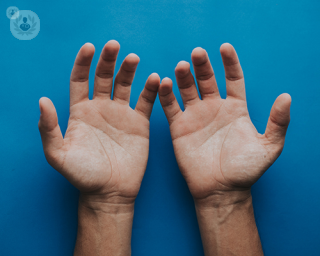

Frequently asked questions about Dupuytren's contracture
By Mr Tim Halsey
2024-11-20
Dupuytren's contracture is a condition which causes fingers to bend, resulting in difficulty in straightening them. Experienced consultant hand and wrist surgeon Mr Tim Halsey explains the condition, including its symptoms, causes and treatment options. See more


What is Dupuytren’s disease?
By Mr James Nicholl
2024-11-19
Dupuytren’s disease or Dupuytren’s contracture is sometimes called the ‘Viking disease’ because it is most commonly found in countries which were invaded by the Vikings. It is a common disease affecting the hands, which usually presents itself in middle age or later in life and is more common in men than women. Mr James Nicholl walks us through this condition and how it can be treated. See more
Experts in Dupuytren’s contracture
-
Mr Kunal Hinduja
Orthopaedic surgeryExpert in:
- Hand surgery
- Dupuytren’s contracture
- Hand injury
- Carpal tunnel surgery
- Trigger finger
- Ganglion cyst
-
Mr Patrick Gillespie
Plastic surgeryExpert in:
- Warts
- Carpal tunnel syndrome
- Dupuytren’s contracture
- Skin cancer
- Cysts
- Hand arthritis
-
Mr G Shyamalan (Shyam)
Orthopaedic surgeryExpert in:
- Carpal tunnel surgery
- Dupuytren’s contracture
- Trigger finger
- Hand surgery
- Ganglion cyst
- Epicondylitis (tennis elbow)
-
Dr Richard Shaffer
Clinical oncologyExpert in:
- Osteoarthritis
- Dupuytren’s contracture
- Keloid scars
- Skin cancer
- Ledderhose disease
- Tendonitis
-
Mr Andrew Logan
Orthopaedic surgeryExpert in:
- Carpal tunnel syndrome
- Dupuytren’s contracture
- Wrist surgery
- Trigger finger
- Hand arthritis
- Hand surgery
- See all

Kings Park Hospital - part of Circle Health Group
Kings Park Hospital - part of Circle Health Group
Polmaise Road Stirling FK7 9JH
No existe teléfono en el centro.
By using the telephone number provided by TOP DOCTORS, you automatically agree to let us use your phone number for statistical and commercial purposes. For further information, read our Privacy Policy
Top Doctors

The Lister Hospital - part of HCA Healthcare
The Lister Hospital - part of HCA Healthcare
Chelsea Bridge Road, London
No existe teléfono en el centro.
By using the telephone number provided by TOP DOCTORS, you automatically agree to let us use your phone number for statistical and commercial purposes. For further information, read our Privacy Policy
Top Doctors

The Priory Hospital - part of Circle Health Group
The Priory Hospital - part of Circle Health Group
Priory Road, Edgbaston, Birmingham B5 7UG
No existe teléfono en el centro.
By using the telephone number provided by TOP DOCTORS, you automatically agree to let us use your phone number for statistical and commercial purposes. For further information, read our Privacy Policy
Top Doctors
-
Kings Park Hospital - part of Circle Health Group
Polmaise Road Stirling FK7 9JH, StirlingExpert in:
- Vascular Surgery
- Cardiology
- Colorectal surgery
- General Surgery
- Neurological spinal surgery
- Plastic surgery, reconstructive and aesthetics
-
The Lister Hospital - part of HCA Healthcare
Chelsea Bridge Road, London , Central LondonExpert in:
- Cancer
- Cardiology
- Orthopaedic surgery
- Pregnancy
- Physiotherapy
- Women’s health
-
The Priory Hospital - part of Circle Health Group
Priory Road, Edgbaston, Birmingham B5 7UG, EdgbastonExpert in:
- Cancer
- General Surgery
- Orthopaedic surgery
- Thoracic Surgery
- Obstetrics and Gynaecology
- Urology
- See all
- Most viewed diseases, medical tests, and treatments
- CAR-T cells
- Hormone therapy
- Migraine
- Hodgkin's lymphoma
- Joint pain
- Lumbar herniated disc
- Spinal surgery
- Minimal access surgery (keyhole surgery)
- Head and neck cancer
- Neck lump
